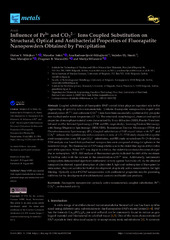| dc.creator | Milojkov, Dusan V. | |
| dc.creator | Sokić, Miroslav | |
| dc.creator | Radosavljevic-Mihajlovic, Ana | |
| dc.creator | Stanic, Vojislav Dj. | |
| dc.creator | Manojlović, Vaso | |
| dc.creator | Mutavdzic, Dragosav R. | |
| dc.creator | Milanovic, Marija | |
| dc.date.accessioned | 2022-03-04T11:16:40Z | |
| dc.date.available | 2022-03-04T11:16:40Z | |
| dc.date.issued | 2021 | |
| dc.identifier.issn | 2075-4701 | |
| dc.identifier.uri | http://TechnoRep.tmf.bg.ac.rs/handle/123456789/4796 | |
| dc.description.abstract | Coupled substitution of fluorapatite (FAP) crystal lattice plays an important role in the engineering of optically active nanomaterials. Uniform fluorapatite nanopowders doped with praseodymium (Pr3+) and carbonate (CO32-) ions have been successfully synthesized by precipitation method under room temperature (25 degrees C). The structural, morphological, chemical and optical properties of monophase material were characterized by X-ray diffraction (XRD), Fourier Transform Infrared and Far Infrared Spectroscopy (FTIR and FIR, respectively), Scanning Electron Microscopy with Energy Dispersive Spectroscopy (SEM/EDS), Transmission Electron Microscopy (TEM) and Photoluminescence Spectroscopy (PL). Coupled substitution of FAP crystal lattice with Pr3+ and CO32- reduces the crystallite size with a constant c/a ratio of 1.72. FTIR study showed that synthesized nanopowders were AB-type CO32- substitution, and FIR study revealed new Pr-O vibrations. TEM analysis was found that synthesized nanopowders were composed of irregular spheres in the nanometer range. The fluorescence of FAP nanoparticles was in the violet-blue region of the visible part of the spectrum. When Pr3+ was doped in a lattice, the violet-blue emission becomes sharper due to reabsorption. MCR-ALS analyses of fluorescence spectra indicated the shift of the maximum to the blue color with the increase in the concentration of Pr3+ ions. Additionally, luminescent nanopowders demonstrated significant antibacterial activity against Escherichia coli. As the obtained nanoparticles showed a good absorption of ultraviolet A light and reabsorption of blue-green luminescence, they are suitable for further development of optically active nanomaterials for light filtering. Optically active PrCFAP nanopowders with antibacterial properties may be promising additives for the development of multifunctional cosmetic and health care products. | en |
| dc.relation | info:eu-repo/grantAgreement/MESTD/inst-2020/200023/RS// | |
| dc.rights | openAccess | |
| dc.rights.uri | https://creativecommons.org/licenses/by/4.0/ | |
| dc.source | Metals | |
| dc.subject | fluorapatite nanopowder | en |
| dc.subject | optically active nanomaterials | en |
| dc.subject | coupled substitution | en |
| dc.subject | Pr3+ | en |
| dc.subject | CO32- | en |
| dc.subject | antibacterial activity | en |
| dc.title | Influence of Pr3+ and CO32- Ions Coupled Substitution on Structural, Optical and Antibacterial Properties of Fluorapatite Nanopowders Obtained by Precipitation | en |
| dc.type | article | |
| dc.rights.license | BY | |
| dc.citation.issue | 9 | |
| dc.citation.other | 11(9): - | |
| dc.citation.rank | M21 | |
| dc.citation.volume | 11 | |
| dc.identifier.doi | 10.3390/met11091384 | |
| dc.identifier.fulltext | http://TechnoRep.tmf.bg.ac.rs/bitstream/id/7321/4792.pdf | |
| dc.identifier.scopus | 2-s2.0-85114105822 | |
| dc.identifier.wos | 000701455500001 | |
| dc.type.version | publishedVersion | |

